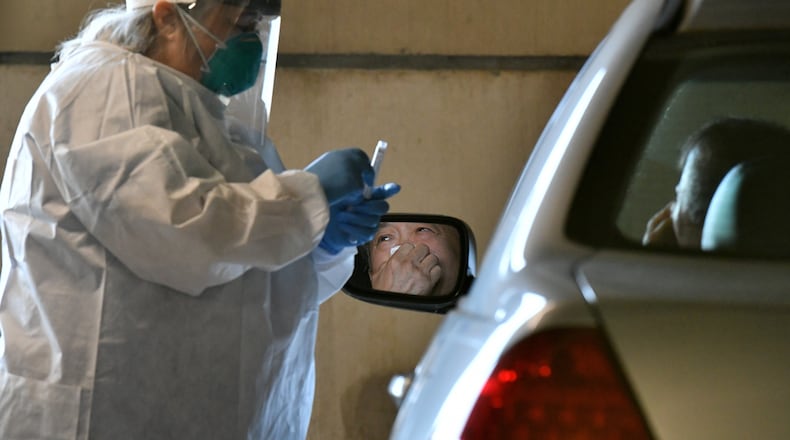Trying to schedule a COVID-19 test appointment at a Gwinnett, Newton and Rockdale County Health Department site can be like pulling the arm of a slot machine. Enter your availability, the site you’re willing to go to, press the big orange NEXT button, and see if you’re lucky enough to see an open slot.
The health department runs two test sites — one at the department headquarters in Lawrenceville and another in Lilburn — with appointments from 7:30 a.m. to noon every day. Appointments are booked up to three days in advance, but between the online scheduling tool and the department’s scheduling hotline, they fill up fast.
Amanda Henke, 34, found out Friday, July 10 that she had been in contact with someone who may have been exposed to the virus. Out of an abundance of caution, she tried to get an appointment for a Gwinnett test site that day, but they were full for the next three days. Henke checked again Monday, July 13, and was able to get an appointment for the morning of July 16.
Though Henke has not experienced symptoms of COVID-19 since her potential exposure, knowing that getting a testing appointment could be difficult made it that much more important to secure one, she said.
“There was a part of me that wanted to get a test while I know they’re available,” Henke said. “The way case numbers are going, they’re probably going to be harder and harder to get.”
The demand continues to increase along with the number of confirmed COVID-19 cases in Gwinnett. It has the most cases of any county in Georgia, and it’s showing no signs of slowing down, said Audrey Arona, health director for the Gwinnett, Newton and Rockdale County Health Department.
Gwinnett was nearing 12,500 total confirmed cases as of Friday, with 1,286 cases per 100,000 people — slightly more than 1% of the county population — according to state data. That is an increase of about 1,000 from noon July 13, four days previous, when the Gwinnett, Newton and Rockdale County Health Department pulled data for its own weekly report. Fulton, the most populous county in the state, had nearly 12,200 confirmed cases Friday, the second highest number in the state. Gwinnett is the second-most populous county in Georgia.
So why not just expand testing? Extend the hours at the existing sites, or add a new site to accommodate more people, perhaps? It’s just not that simple, Arona said. In Gwinnett and other areas with high case numbers, it’s a constant struggle to get the tests and supplies needed to process them.
“It’s a national problem. Everyone, I’m told, is trying to get enough test kits to meet demand,” Arona said. “It varies. Sometimes we’re short on test kits. Sometimes swabs are low. Sometimes it’s the test tubes. Sometimes the reagent is low. It just seems to vary that there’s always one part of the process that’s slow.”
Gov. Brian Kemp has asked the federal government for more testing resources specifically for Gwinnett due to its high case numbers and demand for tests. Arona met with U.S. Surgeon General Jerome Adams and a federal coronavirus response team before the Fourth of July weekend to discuss the county’s needs and identify ways the department can further work to prevent the spread of the virus.
The health department is also working with a private vendor, which Arona did not disclose, to potentially start a mobile testing operation. The vehicle would help health department workers conduct tests across the county and add to the number of people who can get tests each day. Details haven’t been finalized, so there’s no firm launch date, but Arona said she hoped it would get started soon.
When people do get tested — between 800 and 1,000 tests are conducted each day between the two sites — they’re advised they may have to wait seven to 10 days for results. The health department has no control over that wait time, as all tests are processed by LabCorp, a medical laboratory company based in North Carolina. LabCorp would not comment specifically about Gwinnett or Georgia, but said in a statement that wait times nationally have increased due to increased test volume.
“As additional equipment and supplies become available, we expect to be able to expand capacity and improve the time to return results,” the company said in an emailed statement.
But the long turnaround time hampers the health department’s contact tracing efforts, intended to both track where the patient may have caught the virus and find anyone else who may have been exposed, Arona said. The faster they can learn that information, the better the chance they can alert anyone potentially affected and try to stop the spread, she said.
The best approach when waiting for results is to self-isolate as if you have already tested positive, Arona said. Remaining home will prevent the chance of getting infected and potentially invalidating a negative result, or spreading the disease if you do have it. If people follow this guidance, it could be the silver lining of the long wait times, Arona said.
“Hopefully in the long run, it will improve and not lead to community spread,” Arona said.
For those awaiting test results, it can put their life on hold. If the seven to 10-day wait time is accurate, Henke should expect results from her July 16 test between July 23 and July 26. She’s been mostly staying at home in Duluth since the pandemic emerged in Georgia, working from home for her full-time job, but as she waits for her results, she’s stopped taking gigs for her part-time job as a musician. She worries that even if she self-isolates until the results come in, they may not be accurate.
“When you think about it, you can get tested one day, get exposed the next day, get your negative results 10 days later and be infected and not know it,” Henke said. “Having to wait so long feels problematic.”
About the Author
The Latest
Featured


